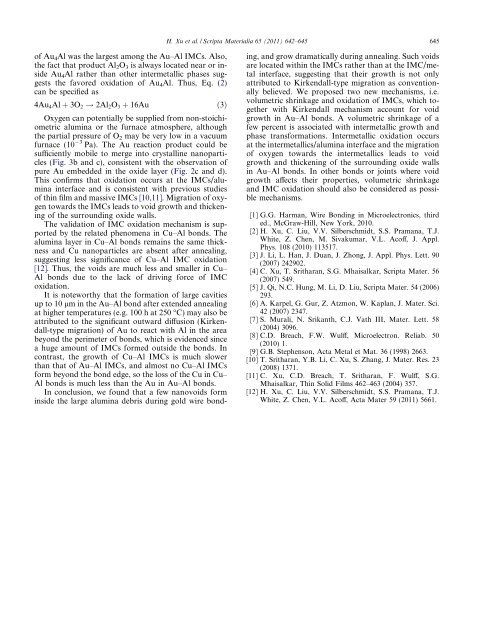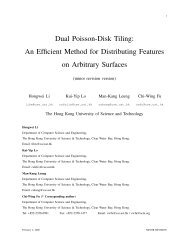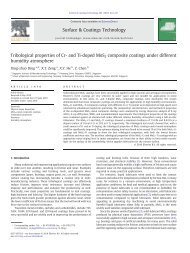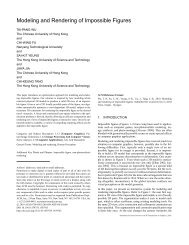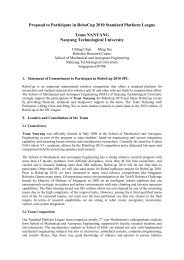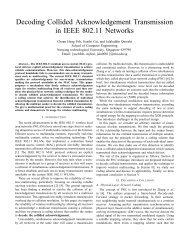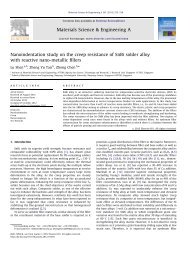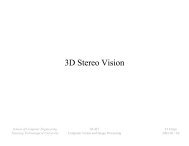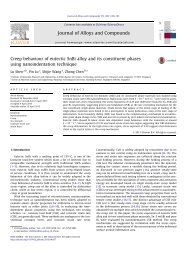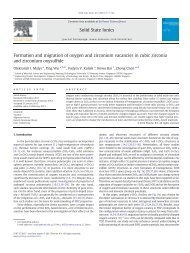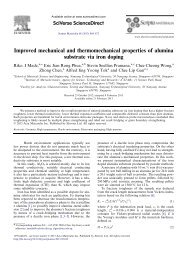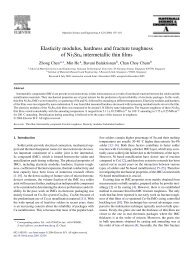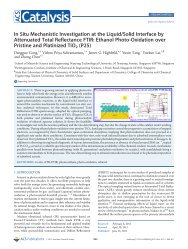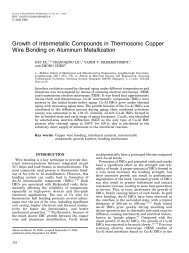New mechanisms of void growth in Au-Al wire bonds - Nanyang ...
New mechanisms of void growth in Au-Al wire bonds - Nanyang ...
New mechanisms of void growth in Au-Al wire bonds - Nanyang ...
Create successful ePaper yourself
Turn your PDF publications into a flip-book with our unique Google optimized e-Paper software.
<strong>of</strong> <strong>Au</strong>4<strong>Al</strong> was the largest among the <strong>Au</strong>–<strong>Al</strong> IMCs. <strong>Al</strong>so,<br />
the fact that product <strong>Al</strong>2O3 is always located near or <strong>in</strong>side<br />
<strong>Au</strong>4<strong>Al</strong> rather than other <strong>in</strong>termetallic phases suggests<br />
the favored oxidation <strong>of</strong> <strong>Au</strong>4<strong>Al</strong>. Thus, Eq. (2)<br />
can be specified as<br />
4<strong>Au</strong>4<strong>Al</strong> þ 3O2 ! 2<strong>Al</strong>2O3 þ 16<strong>Au</strong> ð3Þ<br />
Oxygen can potentially be supplied from non-stoichiometric<br />
alum<strong>in</strong>a or the furnace atmosphere, although<br />
the partial pressure <strong>of</strong> O2 may be very low <strong>in</strong> a vacuum<br />
furnace (10 3 Pa). The <strong>Au</strong> reaction product could be<br />
sufficiently mobile to merge <strong>in</strong>to crystall<strong>in</strong>e nanoparticles<br />
(Fig. 3b and c), consistent with the observation <strong>of</strong><br />
pure <strong>Au</strong> embedded <strong>in</strong> the oxide layer (Fig. 2c and d).<br />
This confirms that oxidation occurs at the IMCs/alum<strong>in</strong>a<br />
<strong>in</strong>terface and is consistent with previous studies<br />
<strong>of</strong> th<strong>in</strong> film and massive IMCs [10,11]. Migration <strong>of</strong> oxygen<br />
towards the IMCs leads to <strong>void</strong> <strong>growth</strong> and thicken<strong>in</strong>g<br />
<strong>of</strong> the surround<strong>in</strong>g oxide walls.<br />
The validation <strong>of</strong> IMC oxidation mechanism is supported<br />
by the related phenomena <strong>in</strong> Cu–<strong>Al</strong> <strong>bonds</strong>. The<br />
alum<strong>in</strong>a layer <strong>in</strong> Cu–<strong>Al</strong> <strong>bonds</strong> rema<strong>in</strong>s the same thickness<br />
and Cu nanoparticles are absent after anneal<strong>in</strong>g,<br />
suggest<strong>in</strong>g less significance <strong>of</strong> Cu–<strong>Al</strong> IMC oxidation<br />
[12]. Thus, the <strong>void</strong>s are much less and smaller <strong>in</strong> Cu–<br />
<strong>Al</strong> <strong>bonds</strong> due to the lack <strong>of</strong> driv<strong>in</strong>g force <strong>of</strong> IMC<br />
oxidation.<br />
It is noteworthy that the formation <strong>of</strong> large cavities<br />
up to 10 lm <strong>in</strong> the <strong>Au</strong>–<strong>Al</strong> bond after extended anneal<strong>in</strong>g<br />
at higher temperatures (e.g. 100 h at 250 °C) may also be<br />
attributed to the significant outward diffusion (Kirkendall-type<br />
migration) <strong>of</strong> <strong>Au</strong> to react with <strong>Al</strong> <strong>in</strong> the area<br />
beyond the perimeter <strong>of</strong> <strong>bonds</strong>, which is evidenced s<strong>in</strong>ce<br />
a huge amount <strong>of</strong> IMCs formed outside the <strong>bonds</strong>. In<br />
contrast, the <strong>growth</strong> <strong>of</strong> Cu–<strong>Al</strong> IMCs is much slower<br />
than that <strong>of</strong> <strong>Au</strong>–<strong>Al</strong> IMCs, and almost no Cu–<strong>Al</strong> IMCs<br />
form beyond the bond edge, so the loss <strong>of</strong> the Cu <strong>in</strong> Cu–<br />
<strong>Al</strong> <strong>bonds</strong> is much less than the <strong>Au</strong> <strong>in</strong> <strong>Au</strong>–<strong>Al</strong> <strong>bonds</strong>.<br />
In conclusion, we found that a few nano<strong>void</strong>s form<br />
<strong>in</strong>side the large alum<strong>in</strong>a debris dur<strong>in</strong>g gold <strong>wire</strong> bond-<br />
H. Xu et al. / Scripta Materialia 65 (2011) 642–645 645<br />
<strong>in</strong>g, and grow dramatically dur<strong>in</strong>g anneal<strong>in</strong>g. Such <strong>void</strong>s<br />
are located with<strong>in</strong> the IMCs rather than at the IMC/metal<br />
<strong>in</strong>terface, suggest<strong>in</strong>g that their <strong>growth</strong> is not only<br />
attributed to Kirkendall-type migration as conventionally<br />
believed. We proposed two new <strong>mechanisms</strong>, i.e.<br />
volumetric shr<strong>in</strong>kage and oxidation <strong>of</strong> IMCs, which together<br />
with Kirkendall mechanism account for <strong>void</strong><br />
<strong>growth</strong> <strong>in</strong> <strong>Au</strong>–<strong>Al</strong> <strong>bonds</strong>. A volumetric shr<strong>in</strong>kage <strong>of</strong> a<br />
few percent is associated with <strong>in</strong>termetallic <strong>growth</strong> and<br />
phase transformations. Intermetallic oxidation occurs<br />
at the <strong>in</strong>termetallics/alum<strong>in</strong>a <strong>in</strong>terface and the migration<br />
<strong>of</strong> oxygen towards the <strong>in</strong>termetallics leads to <strong>void</strong><br />
<strong>growth</strong> and thicken<strong>in</strong>g <strong>of</strong> the surround<strong>in</strong>g oxide walls<br />
<strong>in</strong> <strong>Au</strong>–<strong>Al</strong> <strong>bonds</strong>. In other <strong>bonds</strong> or jo<strong>in</strong>ts where <strong>void</strong><br />
<strong>growth</strong> affects their properties, volumetric shr<strong>in</strong>kage<br />
and IMC oxidation should also be considered as possible<br />
<strong>mechanisms</strong>.<br />
[1] G.G. Harman, Wire Bond<strong>in</strong>g <strong>in</strong> Microelectronics, third<br />
ed., McGraw-Hill, <strong>New</strong> York, 2010.<br />
[2] H. Xu, C. Liu, V.V. Silberschmidt, S.S. Pramana, T.J.<br />
White, Z. Chen, M. Sivakumar, V.L. Ac<strong>of</strong>f, J. Appl.<br />
Phys. 108 (2010) 113517.<br />
[3] J. Li, L. Han, J. Duan, J. Zhong, J. Appl. Phys. Lett. 90<br />
(2007) 242902.<br />
[4] C. Xu, T. Sritharan, S.G. Mhaisalkar, Scripta Mater. 56<br />
(2007) 549.<br />
[5] J. Qi, N.C. Hung, M. Li, D. Liu, Scripta Mater. 54 (2006)<br />
293.<br />
[6] A. Karpel, G. Gur, Z. Atzmon, W. Kaplan, J. Mater. Sci.<br />
42 (2007) 2347.<br />
[7] S. Murali, N. Srikanth, C.J. Vath III, Mater. Lett. 58<br />
(2004) 3096.<br />
[8] C.D. Breach, F.W. Wulff, Microelectron. Reliab. 50<br />
(2010) 1.<br />
[9] G.B. Stephenson, Acta Metal et Mat. 36 (1998) 2663.<br />
[10] T. Sritharan, Y.B. Li, C. Xu, S. Zhang, J. Mater. Res. 23<br />
(2008) 1371.<br />
[11] C. Xu, C.D. Breach, T. Sritharan, F. Wulff, S.G.<br />
Mhaisalkar, Th<strong>in</strong> Solid Films 462–463 (2004) 357.<br />
[12] H. Xu, C. Liu, V.V. Silberschmidt, S.S. Pramana, T.J.<br />
White, Z. Chen, V.L. Ac<strong>of</strong>f, Acta Mater 59 (2011) 5661.


